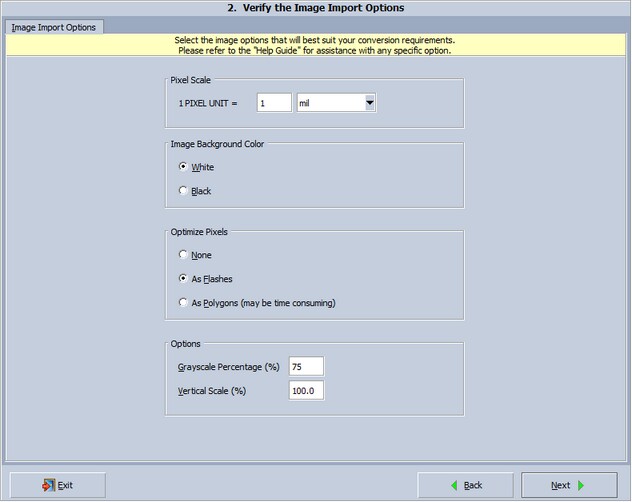Import Image options for image formats (TIFF, PNG, BMP, GIF, etc.)
![]()
![]() Note: Image files are unit-less, and a pixel can theoretically represent any physical size. It is important that you specify the proposed units and scale for a pixels physical size. Choose from Micron, Inch, Millimeter, Centimeter, and more.
Note: Image files are unit-less, and a pixel can theoretically represent any physical size. It is important that you specify the proposed units and scale for a pixels physical size. Choose from Micron, Inch, Millimeter, Centimeter, and more.
![]() Note: Logical pixel size defined by Pixel Units * Image Scale
Note: Logical pixel size defined by Pixel Units * Image Scale
![]() Note: If you have selected potentially wrong units, ACE will issue a warning and make a suggestion.
Note: If you have selected potentially wrong units, ACE will issue a warning and make a suggestion.
Import Image Options:

1 Pixel Unit:
|
Specify the proposed units for each pixels physical size. Choose from DPI, Micron, Inch, Millimeter, Centimeter, and more. |
Image Scale:
|
Logical pixel size defined by Pixel Units * Image Scale |
Image Background Color: |
Select the image's transparent color, that will be ignored during importing. Choose either Black or White. |
Grayscale Percentage (%): |
Black and White Images (such as JPEG's from a microscope) incorporate a "grey blending" which leads to very few background pixels actually being black or white. This setting is a ratio which was developed (by Numerical Innovations) to allow pixels with a "grey-scale" similar to that of the background color to be treated as such. This setting helps with "automatic recognition" of features, and has proved very useful for Failure Analysts(FA) who need photos taken from microscopic devices, converted back to GDSII or Gerber for comparison purposes against the CAD data. |
Optimize Pixels: |
If Checked, this option will generate polygon boundaries for all image geometries. Note: This option can be very time consuming. |
Vertical Scale (%): |
Used to scale the imported image in the Y direction. This can be useful when importing images taken from a microscope which may contain non-uniform scaling. |